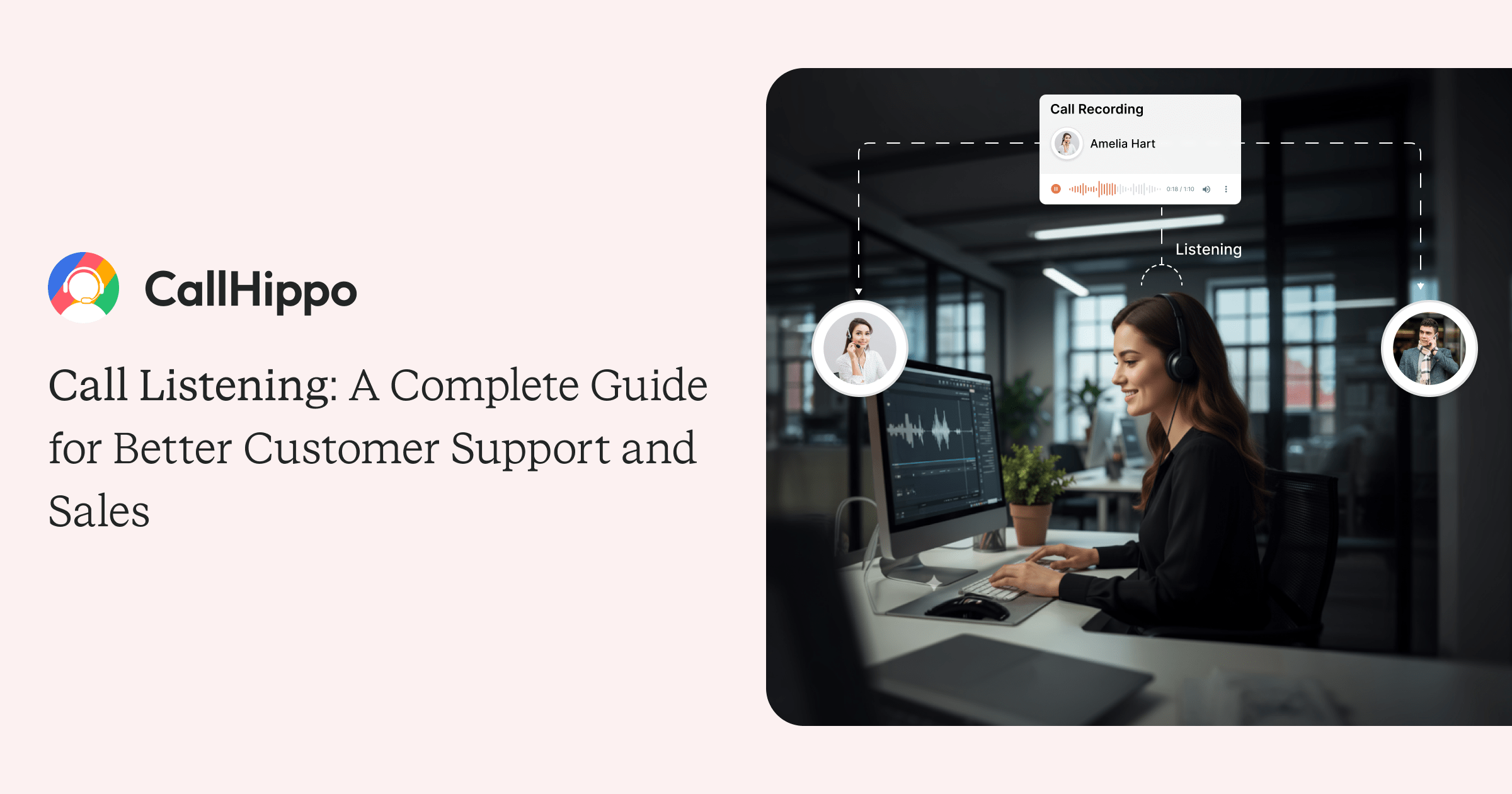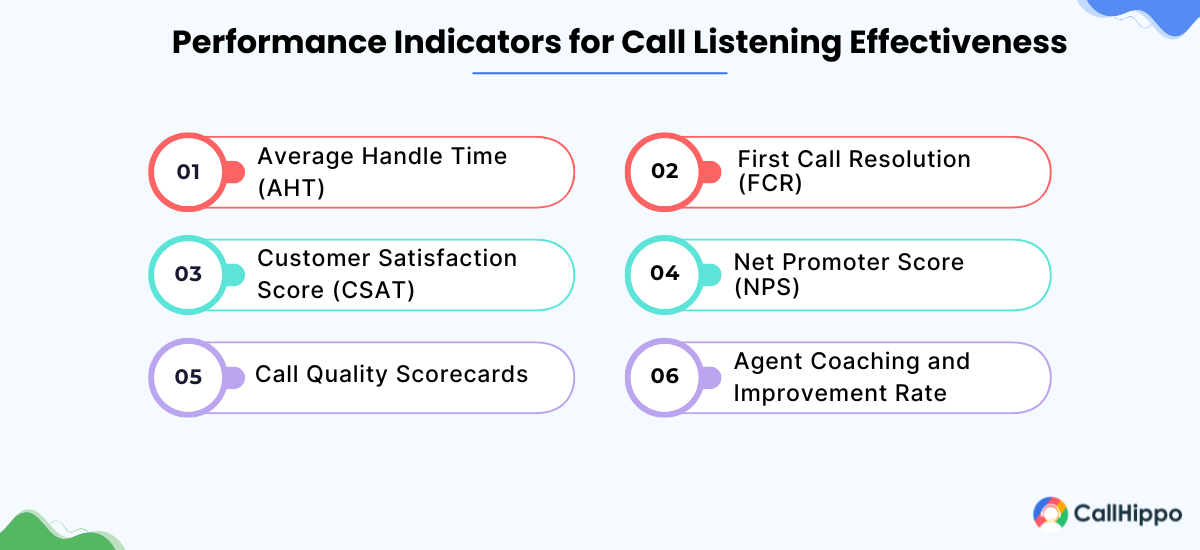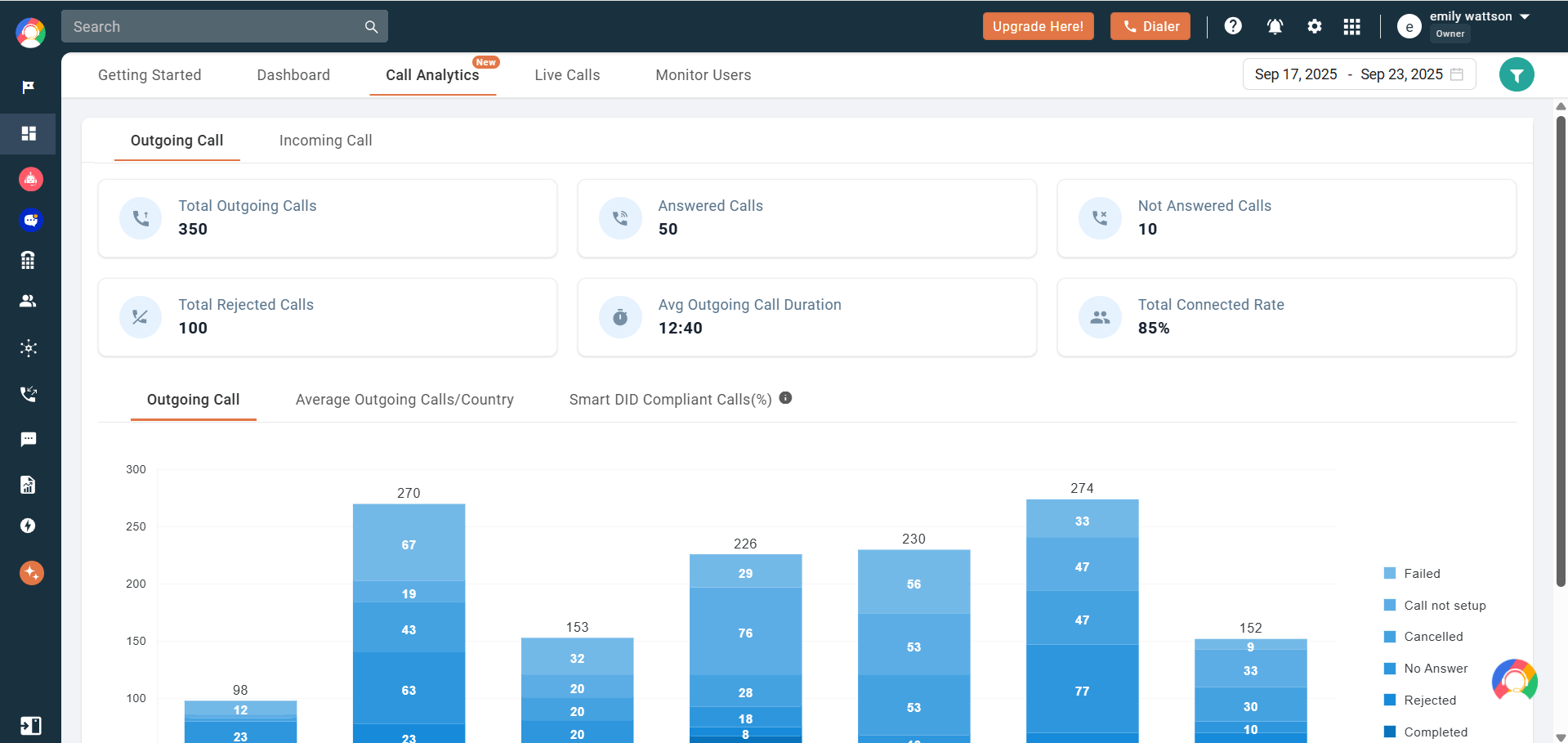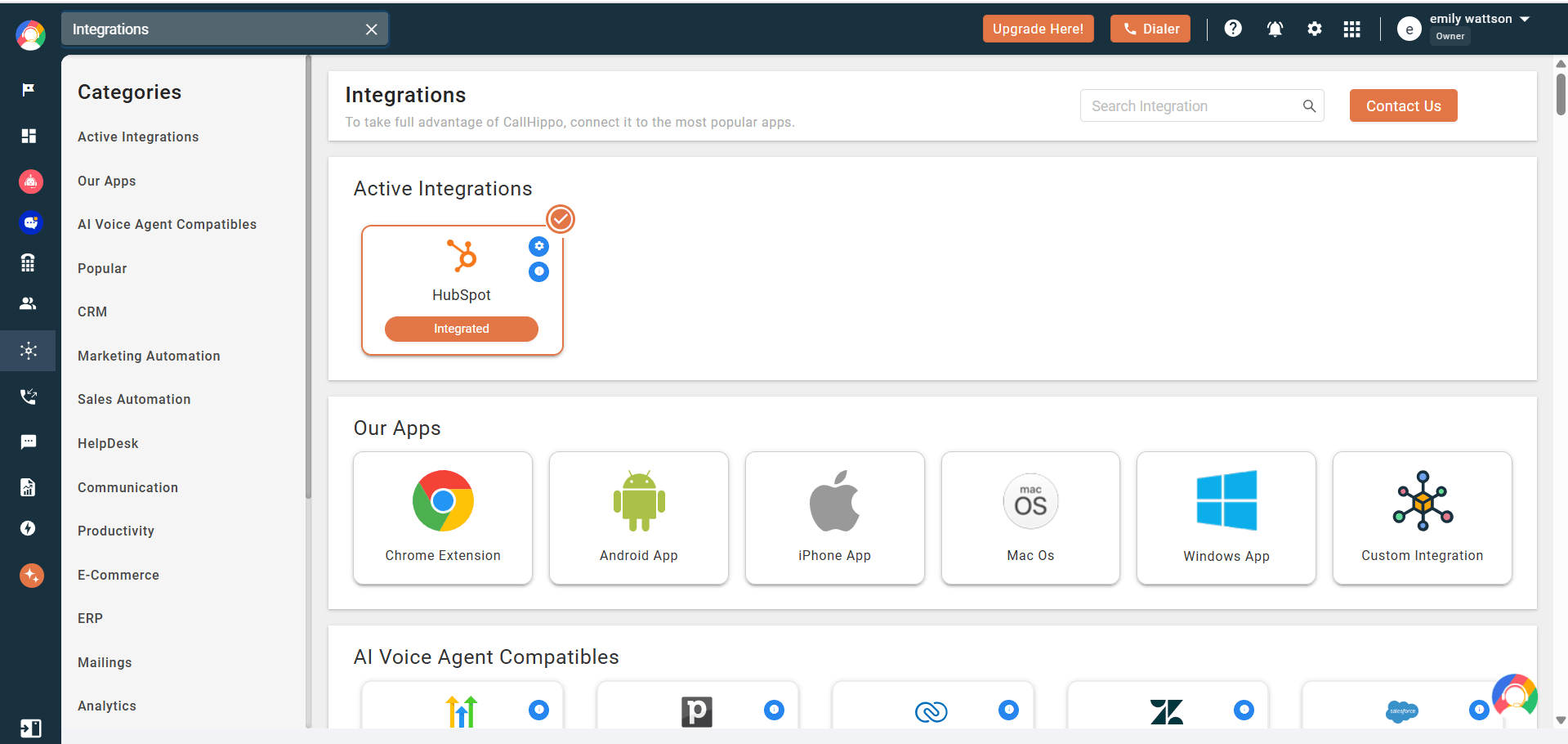

Updated : September 26, 2025
Talking to a customer is not just about solving their problem. It is the moment of truth. With call listening, you can quietly step into that moment. You hear not just what is said, but how it is said. That insight can change everything from coaching your team better to catching the upsell chances that you may miss.
In fact, 80% of consumers still rank phone interactions as their preferred customer service channel.
In this blog, I have detailed the concept of call listening. It is a complete guide on how call listening can apply to your business.
What is Call Listening?
Call Listening is the process where managers or supervisors listen to customer calls in real time or after the call has ended. The goal is not to spy on agents. It is to understand how conversations happen and what customer expectations are. And also, where exactly the customer support agents might need support.
Call centers and contact center teams across industries generally use this practice. This insight helps companies to improve their service quality and train agents with real examples from actual customer conversations. Plus, work on the gaps that could affect customer trust.
How Does a Call Listening Session Work?
A call listening session begins when a manager or supervisor connects to an active or recorded call through the call management system. In live sessions, they listen silently to ongoing conversations and don’t interrupt the customer service representative or the customer. In recorded sessions using call recording technology, they review the conversation at a later date.
Both these methods help them observe the flow of customer interactions and note the areas where attention is needed.
In the call listening process, supervisors listen to how the agent speaks and how quickly they respond to customer queries. This shows if the agent can handle customer needs in the right way. They also check if the agent is following company rules and quality standards.
After the session, call center managers share constructive feedback with the agent. In some cases, the same call is used later as specific examples for team training with new team members.
Quick Takeaway :
- Connect to a live call or recorded calls
- Listen without interrupting the ongoing call
- Observe tone, speed, and adherence to rules
- Provide feedback or use calls for training later
Benefits of Live Call Listening
Live call listening gives managers a real view of customer conversations as they happen. They can guide agents, improve service, and catch issues early. Let’s look at the main benefits:
1. Improved Agent Training and Coaching
When managers listen to live calls, they see the real challenges that the agents actually face during customer interactions. This gives them clear examples to use in training new hires and existing team members.
Customer support agents also get constructive feedback and actionable feedback that helps them learn faster. And over time, this builds confidence. It makes them better at handling customer interactions and addressing common pain points.
2. Enhanced Customer Experience
With live call listening, the supervisors notice the small details that affect the customer’s mood during ongoing conversations. This can be the tone, timing, or even the choice of words that impact better customer service.
Over 50% of retail customers prefer to have support conversations on the phone for any urgent issue. While listening call, managers can ensure that these conversations leave both the customer and service representative feeling heard and cared for.
3. Increased Compliance and Quality Assurance
Many industries have strict rules for customer calls. Live call monitoring helps ensure that the agents follow these rules in real time during ongoing conversations.
It also allows managers to spot the mistakes early. Correcting them on the spot reduces the risk. Plus, it keeps the service quality high and ensures compliance with industry standards.
4. Boosted Sales Performance
Live call listening is useful for sales calls, too. Managers can identify key moments where agents miss chances to upsell or cross-sell during customer conversations.
Timely coaching helps agents learn to grab these opportunities. Over time, this brings higher conversion rates and also better sales numbers from one call to the next.
Call Listening vs. Call Monitoring
The terms call listening and call monitoring often get mixed up. Both involve supervisors checking calls, but they serve slightly different purposes. Let’s look at how they differ:
| Aspect | Call Listening | Call Monitoring |
|---|---|---|
| Definition | Supervisors listen to live or recorded calls without interrupting | Supervisors observe overall call quality, often using monitoring software analytics or scoring |
| Goal | Improve training, coaching, and real-time support | Ensure quality standards, compliance, and performance tracking |
| Interaction | Usually silent; constructive feedback is shared after the call | May involve scoring, reports, and structured evaluation |
| Focus | Conversation flow, tone, and agent performance | Consistency, compliance, and overall service quality |
| Use Case | Training agents or guiding during sales calls | Auditing calls to maintain quality and compliance |
KNOW THIS
Toll-free numbers may not work when calling from outside the United States or they may incur charges. So, check with your provider first before dialing these special numbers.
Call Listening Techniques
There are different ways to use the listening process based on the situation. Each technique serves a unique purpose. It can be used to train agents or guide them during customer calls.
1. Silent Listening
In silent listening, a supervisor joins a live call and doesn’t say anything. The agent and customer don’t actually know that the supervisor is present, listening to the ongoing call.
This helps managers understand how agents handle calls naturally. It also gives real insights into the customer experience without outside influence during customer conversations.
2. Whisper Coaching
In whisper coaching, the supervisors guide agents during a call. The customer here is unaware of this real-time monitoring. The agents get tips in real time while they handle the conversation.
It is useful for training new agents or helping them during complex customer interactions. With this method, agents learn while working, and customers still get smooth service.
3. Call Barging
Call barging allows a supervisor to step into a live call when needed. This technique is not like whispering. Both the customer and agent can hear them during the conversation.
This is often used when the situation is escalating. Managers can take control of the call. They can resolve the issue and then provide constructive feedback to guide the agent forward.
4. Post-call Listening
Post-call listening happens after the call ends. Managers review recorded calls, and they study both sides of the customer conversations using call data.
This is helpful for training sessions and long-term improvements. Customer support agents can hear their own calls and see areas to improve in an objective way.
Pro-Tip
For the best results, use a mix of techniques. Silent listening shows natural behavior. Whisper coaching and barging give agents real-time support when it matters the most during customer interactions.
Metrics & KPIs to Measure the Effectiveness of Call Listening
You might need the right metrics to know if call listening is actually working. These KPIs show how agents perform and how training efforts pay off.


1. Average Handle Time (AHT)
AHT measures how long an agent spends on one call. It includes talk time and any follow-up tasks.
Shorter times may show efficiency, but very low numbers can mean rushed calls. With call listening, managers can balance speed with quality to get better results from customer interactions.
2. First Call Resolution (FCR)
FCR tracks if customer issues are solved in the first call. A higher FCR means fewer callbacks and happier customers with enhanced customer experience.
By listening to calls, supervisors can spot gaps that prevent resolution. Coaching agents on these points can lift FCR scores over time.
3. Customer Satisfaction Score (CSAT)
Customer satisfaction scores are usually measured through post-call surveys. They show how happy customers are with the support they get.
When paired with live call listening, managers can connect survey scores to specific agent behaviors. This helps agents see what works well and what needs to change.
4. Net Promoter Score (NPS)
NPS tells how likely customers are to recommend your business. It reflects the overall impression of service and not just one call.
Listening to calls helps managers understand why customers feel a certain way. They can then coach agents to create more positive experiences and raise NPS.
5. Call Quality Scorecards
Quality scorecards give a structured way to rate calls. They often check compliance, tone, and professionalism.
Supervisors can use live or recorded calls to score performance for an individual agent or an entire call group. Over time, these scores highlight patterns and guide better training.
6. Agent Coaching and Improvement Rate
This measures how well agents grow after constructive feedback. It looks at whether coaching sessions bring real change in performance.
Call listening plays a direct role here. By using actual calls in coaching, managers make training more practical. Plus, the progress becomes easier to track.
Tip to Remember
Don’t track every metric at once. Focus on the few that align with your business goals and improve them step by step.
Call Listening Use Cases
Call listening is not limited to one purpose. It supports many areas of business. Here are some common use cases:
1. Improving Customer Support Quality
Listening to calls helps managers see how agents handle real customer issues. They can notice gaps in tone, empathy, or problem-solving during customer conversations.
With this knowledge, managers guide agents to improve. As a result, customers get smoother conversations and better customer service.
2. Monitoring Compliance and Regulations
In industries like finance or healthcare, following rules is very critical. Call listening ensures that customer support agents follow legal and company standards.
By checking calls, managers can prevent violations before they happen. This protects both the business and the customer.
3. Boosting Sales and Conversions
Sales calls often have hidden chances to upsell or cross-sell. Managers can spot these key moments during listening sessions.
Customer support agents then get trained to act on them at the right time. This helps raise conversion rates and grow revenue.
4. Handling Difficult Customers and Escalations
Some calls involve upset or demanding customers. Call listening gives managers insight into how agents react in these tough moments during customer conversations.
Supervisors can then step in with better strategies. Over time, agents learn how to calm tense situations and handle escalations.
5. Gathering Customer Insights for Business Strategy
Customer calls are full of feedback that surveys may miss. Call listening captures these valuable insights directly from customer conversations.
When analyzed, these valuable insights show patterns in customer needs or common pain points. Leaders can use them to shape smarter business strategies.
Expert Insight
Don’t use call listening just for fixing issues. Treat it as a source of customer insights that can guide sales, support, and business strategy.
What Are the Key Features to Look for in Call Listening Tools?
Not all listening tools are the same. The right features make them useful for both managers and agents. Here are the ones to look for:
1. Whisper and Barge Functions
Whisper allows managers to guide agents during live calls. The customer here is unaware that the supervisor is listening. Barge lets them join when needed, and the customer can hear them.
Together, these features give real-time control. They help during tough calls and make sure that the agents have support when it matters.
2. Call Analytics and Reporting
Call Analytics provide call data details like call duration, response speed, and talk-to-listen ratios. Reports give a bigger view of trends over time.


With these insights, managers can track patterns and identify areas for improvement. This makes training and decision-making more data-driven.
3. Integration with CRM Systems
When listening tools connect with a CRM, all customer data stays in one place. This makes it easier to see the full customer journey.


Customer support agents can also access past details while on calls. This helps them respond faster and with more context.
4. Security and Data Privacy Features
Customer calls often include sensitive information. Security features like encryption and access control keep this call data safe.
Strong privacy settings also ensure only authorized staff can access calls. This builds trust with customers while keeping businesses compliant.
Turn Every Call into an Opportunity
Better calls mean better business. CallHippo helps you coach agents live, improve service, and close more sales.
Challenges in Call Listening and How to Overcome Them
Call listening is powerful, but it also comes with challenges. These need to be handled carefully to make the listening process fair and effective.
1. Agent Resistance or Anxiety
Customer support agents may feel nervous when they know that their calls are being monitored. This can possibly affect their confidence and natural style during customer interactions.
This needs to be eased. For this, the managers should explain the purpose clearly. When agents see it as support rather than control, they respond better.
2. Ensuring Customer Privacy
Calls often contain personal details. If the customers feel that their privacy is at risk, the trust can drop.
Using secure tools and being transparent about policies is key. This way, both agents and customers feel safe.
3. Avoiding Over-Monitoring
If you monitor too much, it may make the agents feel that they are being watched all the time. This can cause them stress and also bring their morale down.
The solution here is balance. Monitor enough to improve performance. But you need to give your customer support agents some space, also.
4. Choosing the Right Software
All listening tools are not equal. Some may lack features or security. Others may be too complex to use.
The right choice depends on the business needs. Simple, secure, and integration-friendly tools are often the best fit.
Author’s Advice
- Always explain the purpose of call listening to your agents
- Focus on improvement, not punishment
- Use secure tools to protect both customer and business data
- Turn every listening session into a learning opportunity
Conclusion
Call listening is not just a management tool. It is a way to understand both your agents and your customers better. You need to use it with care. It builds stronger teams, happier customers, and better business results.
Start small. Use the right tools, and treat every call as a chance to improve. The more you listen, the more you learn.
FAQs
Is live call listening legal?
Yes! Call listening is legal in many regions, but it all depends on the local laws. Some places require one-party consent. Others may need both parties to agree. Businesses should always follow privacy rules and inform agents and customers if required.
Which industries benefit most from call listening?
Industries that rely on customer interaction benefit the most. These include retail, banking, healthcare, travel, and SaaS. Call listening helps improve service, ensure compliance, and boost sales. Any business that manages customer calls can benefit from this practice.
What are the best tools for call listening?
CallHippo is the leading tool for call listening. It offers whisper coaching, call barging, and more. Other good options are Ringover, Vonage, OpenPhone, and MightyCall. The best choice depends on business needs. The tools with analytics, integrations, and strong security are often the most effective.
Published : September 26, 2025

Shubham Nikam, Senior Product Marketing Specialist, brings 5 years of experience in VoIP demand generation and lead generation. He specializes in B2B SaaS, focusing on cloud telephony and CCaaS. Shubham excels in developing go-to-market strategies, optimizing product messaging, and leveraging AI tools to drive growth and customer acquisition.


Let’s Stay in Touch
Subscribe to our newsletter & never miss our latest news and promotions.
![]()
![]() +24K people have already subscribed
+24K people have already subscribed
Source



